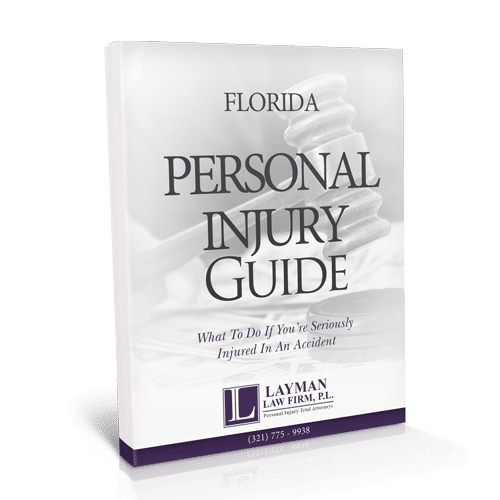Melbourne Broken Bone Injuries or Amputations Lawyers
Most of us take for granted the amazing mobility and agility of our human bodies. A broken bone or amputation can dramatically reduce that mobility and agility, forcing you to adapt to the sudden limitations placed on your body. The physical, emotional, and financial ramifications of a broken bone or amputation can be devastating. If a broken bone or amputation was caused, in whole or in part, by the negligence of another party, you may be entitled to compensation for your injuries.
The experienced Melbourne broken bone injuries or amputations lawyers at Layman Law Firm, P.L. understand how your injuries have impacted your life and your future. We have the experience and commitment needed to help identify the negligent party (or parties) and hold them accountable by aggressively pursuing your right to be fully and fairly compensated for all your injuries.
What Is a Broken Bone Injury?
Although we commonly use the term “broken bone,” the medical field refers to these injuries as “fractures.” A fracture may occur in several ways and may cause the bone to be completely or partially fractured and may leave a split in the bone or crush the bone into multiple pieces. According to the Cleveland Clinic, several important terms are used to describe the type and severity of a bone fraction, including:
- Closed fracture. When the injury does not break open the skin.
- Open fracture. When the injury does break open the skin.
- Complete fracture. The break goes completely through the bone, separating it in two.
- Displaced fracture. A gap forms where the bone breaks.
- Partial fracture. The break does not go all the way through the bone.
- Stress fracture. A crack in the bone.
- Avulsion. Occurs when a tendon or ligament pulls part of the bone off.
- Comminuted. Meaning the bone has shattered into several different pieces.
- Compression. The bone gets crushed or flattened.
- Impacted. Happens when bones are driven together.
- Oblique. A break that goes diagonally across the bone.
- Spiral. A fracture that spirals around the bone.
- Transverse. A break that goes in a straight line across the bone.
What Are Some Common Causes of Broken Bone Injuries?
According to the American Academy of Orthopaedic Surgeons (AAOS), the most common causes of bone fractures are:
- Trauma. A fall, motor vehicle accident, or tackle during a football game can all result in fractures.
- Osteoporosis. This disorder weakens bones and makes them more likely to break.
- Overuse. Repetitive motion can tire muscles and place more force on the bone. This can result in stress fractures. Stress fractures are more common in athletes.
How Are Broken Bone Injuries Treated?
The methods used to treat a broken bone injury, as well as the long-term prognosis for the patient, will depend on several factors, including the type of fracture, severity of the fracture, and the absence or presence of complicating factors (such as infection). Treatment for a broken bone may include:
- Cast Immobilization. After repositioning the bone, a plaster or fiberglass cast is applied to keep the bone in proper alignment while it heals.
- Functional Cast or Brace. A more functional cast or brace may suffice for less serious fractures.
- Traction. Traction involves a steady pulling motion designed to align a bone or bones.
- External Fixation Surgery. Metal pins or screws are placed into the broken bone above and below the fracture site. The pins or screws are connected to a metal bar outside the skin, creating a stabilizing frame that holds the bones in the proper position while they heal.
- Open Reduction and Internal Fixation Surgery. Bone fragments are surgically repositioned into their normal alignment and held together with special screws, rods inserted through the center of the bone, or by attaching metal plates to the outer surface of the bone.
What Is an Amputation Injury?
Amputation is the loss or removal of all or part of a limb or extremity. There are almost two million people living in the United States with limb loss. Common examples of amputations include:
- Above-knee amputation removes part of the thigh, knee, shin, foot, and toes.
- Below-knee amputation that removes the lower leg, foot, and toes.
- Arm amputation.
- Hand amputation.
- Finger amputation.
- Foot amputation that removes part of the foot.
- Toe amputation.
What Are the Common Causes of Amputation Injuries?
When a body part is cut off or torn away in a severe accident or is so badly damaged from a crush injury or severe burns that it cannot be saved, it is referred to as a “traumatic amputation.” Traumatic amputations are often the result of a motor vehicle collision, occupational or industrial accident, or combat injury. In fact, traumatic amputation injuries account for about 45 percent of all amputations, according to Johns Hopkins University.
“Surgical amputation” is the term used when tissue destruction (such as the result of frostbite), infection, or disease affects a body part in a way that makes it impossible to repair or that endangers the person’s life.
How Are Amputation Injuries Treated?
Amputation surgery removes all diseased or damaged tissue as well as crushed bone. Jagged or even bones may need to be smoothed and blood vessels sealed. Finally, muscles may need to be reshaped to accommodate a prosthetic limb. Even without complications following surgery, an amputation injury will require lifetime care. The National Institutes of Health (NIH) estimates the average lifetime cost of treating an amputation injury to be over half a million dollars. Common complications following an amputation surgery that may significantly increase that cost include:
- Infection
- Swelling
- Excessive bleeding
- Muscle weakness
- Pain, including “phantom limb” pain
Am I Entitled to Compensation for My Melbourne Broken Bone or Amputation Injury?
A significant percentage of broken bone and amputation injuries are caused by traumatic events, such as a motor vehicle or motorcycle accident, pedestrian or bicycle accident, or slip and fall accident. While we refer to these as “accidents,” they are more often the result of negligence on the part of another party. When that is the case, a victim may be entitled to compensation for the economic and non-economic damages suffered because of that negligence. Economic damages are intended to compensate a victim for objective, easily proven, damages, including things such as:
- Medical expenses, including doctor, hospital, and therapist expenses
- Rehabilitation, in-home care, and long-term care costs
- Lost income or loss of earning capacity
- Specialized medical equipment
Non-economic damages compensate an injured victim for the subjective damages caused by the defendant’s negligence, such as:
- Pain and suffering
- Emotional distress
- Loss of enjoyment of life
- Disfigurement
- Mental anguish
- Loss of consortium
Contact the Experienced Melbourne Broken Bone Injuries or Amputations Lawyers at Layman Law Firm, P.L.
If you suffered a broken bone or amputation injury and you believe that someone else’s negligent or wrongful conduct caused or contributed to your injury, contact the experienced and compassionate Melbourne broken bone injuries or amputations lawyers at Layman Law Firm, P.L. to discuss your legal options. Contact the team today for your free initial consultation by calling 321-773-2111 or by filling out our convenient Intake Evaluation Form online.






